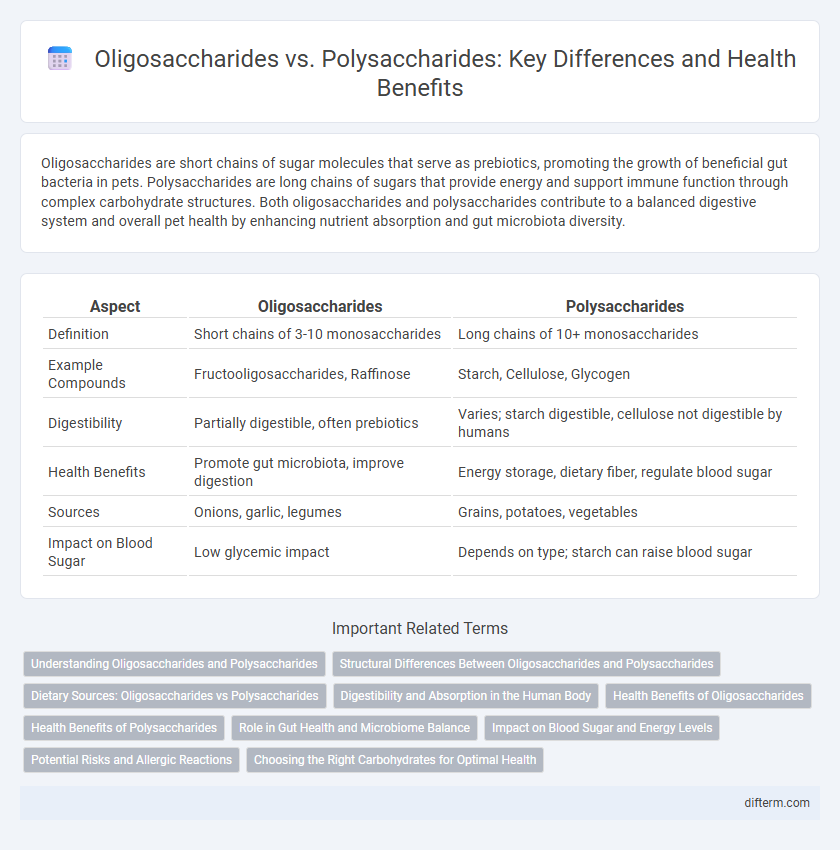Oligosaccharides are short chains of sugar molecules that serve as prebiotics, promoting the growth of beneficial gut bacteria in pets. Polysaccharides are long chains of sugars that provide energy and support immune function through complex carbohydrate structures. Both oligosaccharides and polysaccharides contribute to a balanced digestive system and overall pet health by enhancing nutrient absorption and gut microbiota diversity.
Table of Comparison
| Aspect | Oligosaccharides | Polysaccharides |
|---|---|---|
| Definition | Short chains of 3-10 monosaccharides | Long chains of 10+ monosaccharides |
| Example Compounds | Fructooligosaccharides, Raffinose | Starch, Cellulose, Glycogen |
| Digestibility | Partially digestible, often prebiotics | Varies; starch digestible, cellulose not digestible by humans |
| Health Benefits | Promote gut microbiota, improve digestion | Energy storage, dietary fiber, regulate blood sugar |
| Sources | Onions, garlic, legumes | Grains, potatoes, vegetables |
| Impact on Blood Sugar | Low glycemic impact | Depends on type; starch can raise blood sugar |
Understanding Oligosaccharides and Polysaccharides
Oligosaccharides are short chains of 3 to 10 simple sugars linked together, playing a crucial role in gut health by promoting beneficial bacteria growth and aiding digestion. Polysaccharides consist of longer, complex carbohydrate chains, such as starch and cellulose, providing sustained energy and supporting immune function through dietary fiber. Understanding their distinct structures and functions helps optimize dietary choices for improved metabolic health and microbiome balance.
Structural Differences Between Oligosaccharides and Polysaccharides
Oligosaccharides consist of 3 to 10 monosaccharide units linked by glycosidic bonds, exhibiting simpler branched or linear structures, while polysaccharides are composed of more than 10 monosaccharide units forming complex, often highly branched or linear macromolecules. The structural differences influence their solubility, digestibility, and function in biological systems, with oligosaccharides typically serving as prebiotics and polysaccharides functioning as energy storage or structural components. Variations in glycosidic linkage types, such as a or b bonds, further define the biological roles and breakdown pathways of these carbohydrates.
Dietary Sources: Oligosaccharides vs Polysaccharides
Dietary oligosaccharides are primarily found in legumes, onions, garlic, and asparagus, serving as prebiotics that support gut health by promoting beneficial bacteria growth. Polysaccharides, such as starch and cellulose, are abundant in whole grains, potatoes, and vegetables, providing sustained energy and dietary fiber essential for digestive health. Both types of carbohydrates contribute uniquely to nutrition, with oligosaccharides enhancing microbiome diversity and polysaccharides supplying bulk and energy.
Digestibility and Absorption in the Human Body
Oligosaccharides are partially digestible by human enzymes, allowing them to be absorbed in the small intestine and also serve as prebiotics in the colon. Polysaccharides, particularly starches, undergo extensive enzymatic breakdown into simpler sugars before absorption occurs in the small intestine. Dietary fiber polysaccharides resist digestion, reaching the colon where they ferment, influencing gut microbiota and promoting overall digestive health.
Health Benefits of Oligosaccharides
Oligosaccharides, short-chain carbohydrates composed of 3 to 10 monosaccharide units, play a crucial role in gut health by serving as prebiotics that stimulate beneficial bacteria growth, such as Bifidobacteria and Lactobacilli. These compounds enhance immune function, improve mineral absorption, and contribute to better digestive health by reducing inflammation and preventing pathogenic bacteria proliferation. Unlike polysaccharides, which are long-chain carbohydrates involved mainly in energy storage, oligosaccharides uniquely support the microbiome's balance, promoting overall wellness and disease prevention.
Health Benefits of Polysaccharides
Polysaccharides, complex carbohydrates found in foods like mushrooms, oats, and seaweed, offer significant health benefits such as boosting immune function and promoting gut health by acting as prebiotics. Their ability to modulate blood sugar levels and reduce cholesterol contributes to cardiovascular health. Unlike oligosaccharides, polysaccharides provide sustained energy and support long-term digestive wellness through their soluble fiber content.
Role in Gut Health and Microbiome Balance
Oligosaccharides act as prebiotics, selectively stimulating the growth of beneficial gut bacteria such as Bifidobacteria and Lactobacilli, thereby enhancing microbiome diversity and promoting gut barrier function. Polysaccharides like dietary fiber contribute to gut health by providing bulk, supporting fermentation processes, and producing short-chain fatty acids that nourish colon cells and reduce inflammation. Both oligosaccharides and polysaccharides play crucial complementary roles in maintaining microbiome balance and optimizing digestive health.
Impact on Blood Sugar and Energy Levels
Oligosaccharides, composed of a few simple sugars, have a lower glycemic index, causing a slower and more gradual rise in blood sugar levels compared to polysaccharides, which are long chains of sugar molecules that typically lead to a quicker spike and subsequent drop in glucose. This steady blood sugar increase from oligosaccharides supports sustained energy release and better metabolic regulation. Polysaccharides, found in foods like starches, provide rapid energy bursts but may contribute to energy crashes and insulin resistance if consumed excessively.
Potential Risks and Allergic Reactions
Oligosaccharides can cause digestive discomfort and bloating due to fermentation by gut bacteria, particularly in individuals with irritable bowel syndrome (IBS). Polysaccharides, especially those derived from certain plants or fungi, may trigger allergic reactions in sensitive individuals, causing symptoms ranging from mild rashes to severe anaphylaxis. Understanding individual tolerance and potential allergenic sources is crucial for minimizing health risks associated with these carbohydrates.
Choosing the Right Carbohydrates for Optimal Health
Oligosaccharides, consisting of 3 to 10 sugar units, support gut health by promoting beneficial bacteria and improving digestion, whereas polysaccharides, such as starch and cellulose, provide sustained energy and dietary fiber essential for metabolic balance. Choosing the right carbohydrates involves prioritizing complex carbohydrates with low glycemic index values to regulate blood sugar levels and prevent chronic diseases like diabetes. Incorporating a variety of oligosaccharides and polysaccharides from whole grains, legumes, fruits, and vegetables enhances nutrient absorption, immune function, and overall digestive health.
Oligosaccharides vs Polysaccharides Infographic

 difterm.com
difterm.com